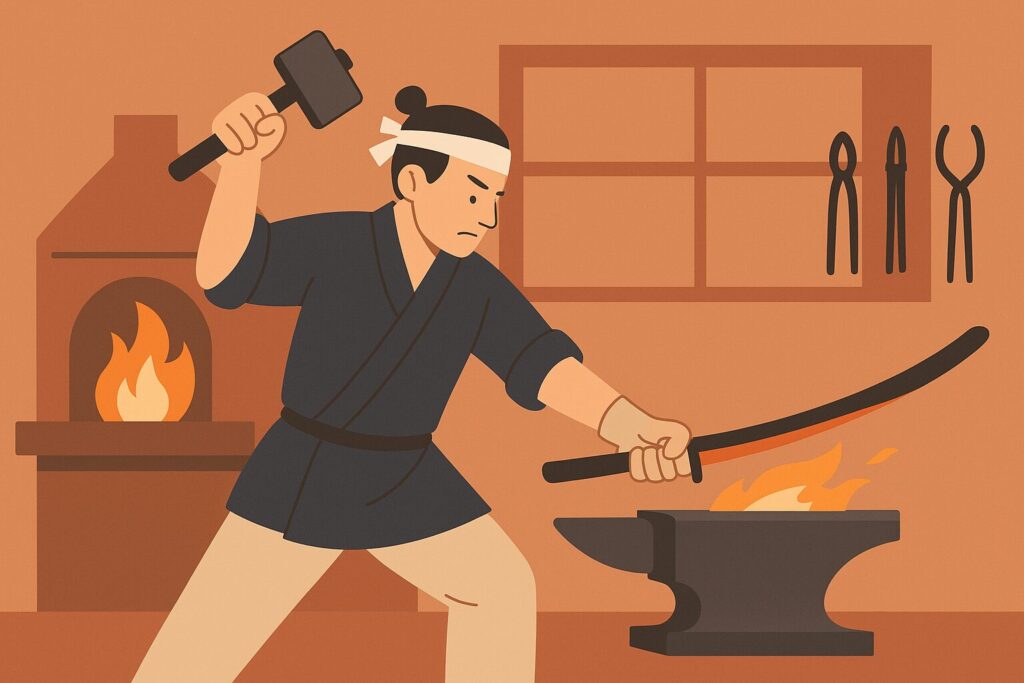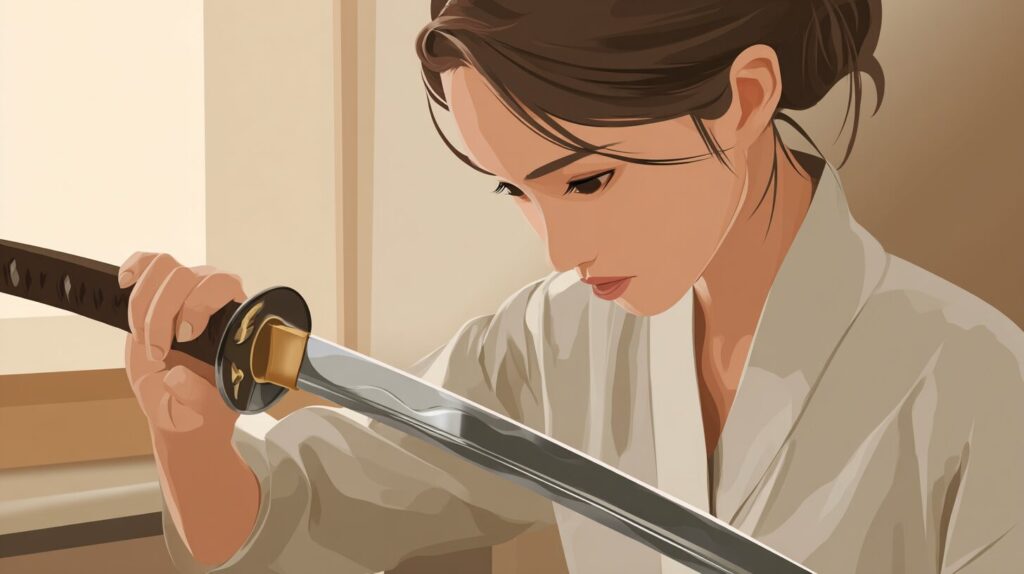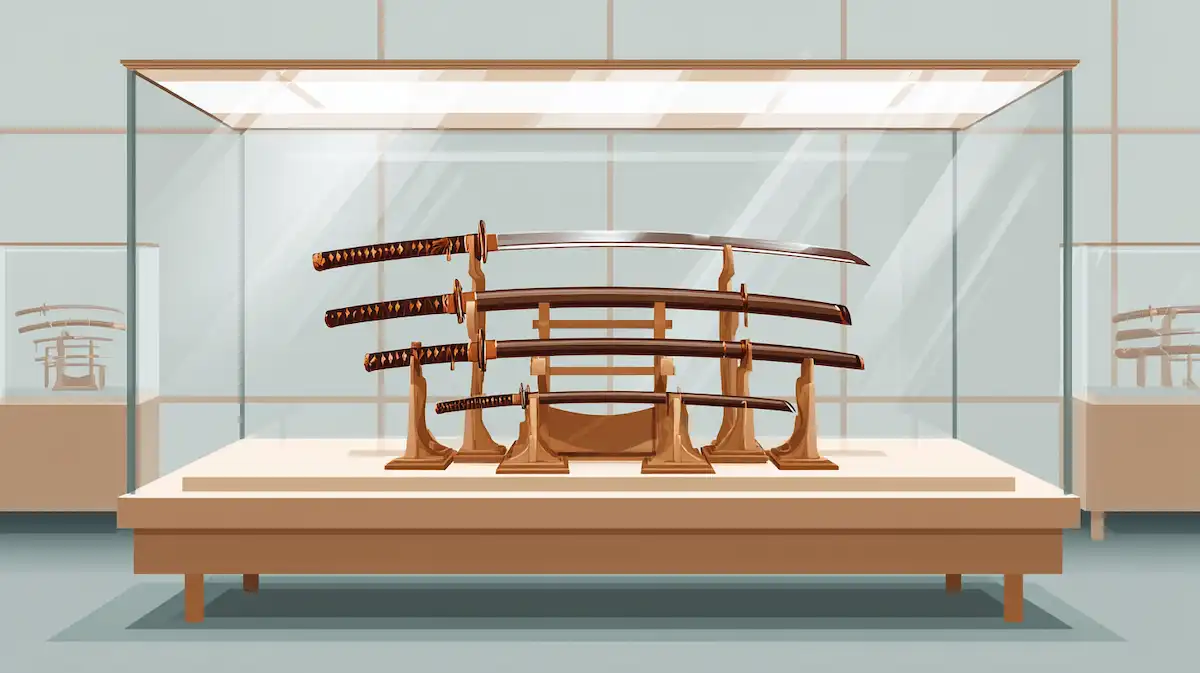日本刀を英語で説明・紹介するための基本情報と、英会話に役立つ表現をシンプルでわかりやすい英語で紹介します。
英会話ダイアローグ・概要・10の質問を通して、日本刀に関する英語表現を学びます。
英語
英会話ダイアローグを読む前に知っておくと良い前提知識と情報です。
- 日本刀の基本的な知識
- 単なる武器ではなく、美術品としての価値も高く評価されている
- 太刀(たち)、打刀(うちがたな)、短刀(たんとう)など様々な種類がある
- 刃(は)、棟(むね)、鍔(つば)、柄(つか)など、各部分には固有の名称がある
- 日本刀は武士の魂とも言われ、武士道の象徴
- 製作技術と素材
- 玉鋼(たまはがね)と呼ばれる高品質の鉄を原料としている
- 「折り返し鍛錬」という技法で鋼を何度も折り重ねて不純物を取り除き、強度と柔軟性を高める
- 刃と背に異なる硬度を持たせる「差し土」という独特の熱処理技術がある
- 現代における日本刀文化
- 現在も約200人の刀匠が伝統的な技法で刀を製作している
- 日本刀は高額なコレクション対象となっており、特に名工の作品は非常に価値が高い
- 日本刀剣博物館(東京)や名古屋刀剣ワールドなどの専門博物館が存在する
- 人気を支えるポップカルチャー
- 『刀剣乱舞』などのゲームでは、日本刀がキャラクター化され、多くの若者に人気
- サムライ映画やアニメを通じて、日本刀の魅力が世界中に広がっている
2人が日本刀について話しています。
日本刀の魅力や特徴、日本刀の美しい曲線や刃文、刀匠の技術、博物館での展示などを話題にしています。
会話 / dialogue

Hey Key, did you know Japanese swords are still really popular today?

Yeah, I’ve heard that! People still collect them and even use them for martial arts.

Exactly. I was surprised to learn that there are still about 200 swordsmiths in Japan making real swords by hand.

Really? I thought it was just something from the past. But I guess it’s a living craft, right?

Yes, it is! In fact, museums like the Japanese Sword Museum in Tokyo and Nagoya Touken World display hundreds of swords. Some are even over 400 years old.

That’s amazing! I also heard the Hamon patterns on the blade are unique. It’s like a fingerprint for each sword.

Exactly! During the cooling process, the blade forms these wave-like patterns. It’s not just decoration—it shows where the blade is the hardest.

I love that it’s both art and a weapon. I heard the curve in the blade isn’t just for looks.

You’re right. The curve makes it easier to draw quickly and cut smoothly. That’s why samurai could cut in one swift motion.

That makes so much sense. And the steel is folded many times, right?

Yes, it’s called Tamahagane. They fold it over and over to make it strong and flexible. This process also creates beautiful wood-grain patterns on the blade.

I didn’t know it was so detailed. It’s really like a piece of art.

That’s why collectors love it. Some swords are sold for millions of dollars!

Millions? That’s incredible! So, people still use them for martial arts?

Yes, they practice Iaido, which is the art of drawing and cutting with the sword. Some people also buy replicas or even real swords to practice.

I’d love to see that someday. Do you think we can visit a museum here in Tokyo?

Definitely! The Japanese Sword Museum has a lot of displays. You can see the Hamon, the curves, and even learn about how they were made.

That sounds really cool. Maybe we can even see a forging demonstration.

That would be awesome. I actually want to know more about how the swordsmiths work. It’s like connecting with history.

Yeah, it’s not just a weapon; it’s part of Japanese culture and spirit. The samurai used to call it their soul.

Right, it symbolized honor and loyalty. Even today, people admire that spirit.

I can understand why it’s still so popular. It’s not just a sword; it’s a living piece of history.

Exactly. I’m definitely going to learn more about it. Maybe we can visit some exhibitions together.

Count me in! I’m really curious to see those beautiful patterns up close.
概要 / Overview
「日本刀」について、理解を深めるための「英語での概要」です。
日本刀

What is a Japanese Sword?
A Japanese sword, called Nihontō, is a traditional weapon made with a single sharp edge and a beautiful curve. It is famous for its cutting ability and elegant design. Samurai warriors used Japanese swords for hundreds of years, and they are still admired today as both weapons and works of art.
How Are Japanese Swords Made?
Japanese swords are made from special steel called Tamahagane. Swordsmiths fold the steel many times during the forging process. This makes the blade both strong and flexible. The sword is then heated and cooled quickly. This process creates a unique wave-like pattern on the blade, called the Hamon. Each Hamon is different, making every sword unique.
The Beauty of the Blade
The shape of a Japanese sword is not only beautiful but also functional. The curve allows for quick drawing and smooth cutting. The blade is polished carefully to show the Hamon and the wood-grain patterns. Even the handle and guard are beautifully decorated, making the sword a piece of art.
Popularity Today
Japanese swords are still popular today. Museums in Japan, like the Japanese Sword Museum in Tokyo, display many beautiful swords. People also practice Iaido, a martial art that uses Japanese swords for training. Collectors around the world admire their beauty and history. Some swords are even sold for millions of dollars.
A Living Tradition
Japanese swords are not just weapons; they are symbols of honor, tradition, and craftsmanship. Even today, about 200 swordsmiths in Japan continue to make them using traditional methods. Japanese swords are a connection to history, and they remain a symbol of Japanese spirit and culture.
10の質問 / 10 questions
「日本刀」について、理解を深めるための「英語での10の質問」です。
1: What is a Japanese sword (Nihontō)?
A Japanese sword, called Nihontō, is a traditional weapon known for its sharp edge and elegant curved shape. It is famous for its cutting ability and artistic design.
2: What material is used to make Japanese swords?
Japanese swords are made from a special type of steel called Tamahagane. This steel is folded many times during the forging process to make it strong and flexible.
3: What is the purpose of folding the steel many times?
Folding the steel many times removes impurities and creates layers. This makes the blade both strong and flexible, with a beautiful wood-grain pattern on the surface.
4: What is Hamon?
Hamon is a wave-like pattern on the blade that is created during the cooling process. It is unique to each sword and shows the hard part of the blade.
5: Why is the curve in a Japanese sword important?
The curve makes it easier to draw the sword quickly and cut smoothly. This design helped samurai make fast and effective strikes.
6: Are Japanese swords still made today?
Yes, there are still about 200 swordsmiths in Japan who make swords by hand using traditional methods. The craft is protected and recognized as a cultural heritage.
7: Where can people see Japanese swords?
People can see Japanese swords in museums like the Japanese Sword Museum in Tokyo and Nagoya Touken World. These museums display many historical and modern swords.
8: What is Iaido?
Iaido is a Japanese martial art that focuses on drawing and cutting with a sword. Practitioners use real or replica swords to practice precise movements.
9: Are Japanese swords expensive?
Yes, Japanese swords can be very expensive. Some are sold for millions of dollars because of their history, craftsmanship, and beauty.
10: Why are Japanese swords considered works of art?
Japanese swords are not only weapons but also beautiful objects. Their elegant shape, unique patterns, and careful craftsmanship make them admired as art pieces.

和訳付
会話 / dialogue

Hey Key, did you know Japanese swords are still really popular today?
ねえキー、日本刀が今でもすごく人気があるって知ってた?

Yeah, I’ve heard that! People still collect them and even use them for martial arts.
うん、聞いたことあるよ!今でもコレクションする人もいるし、武道で使う人もいるんだよね。

Exactly. I was surprised to learn that there are still about 200 swordsmiths in Japan making real swords by hand.
その通りだよ。日本には今でも約200人の刀匠がいて、手作業で本物の刀を作っているって知って驚いたよ。

Really? I thought it was just something from the past. But I guess it’s a living craft, right?
本当に?昔のものだけだと思ってた。でも、今も生きている伝統なんだね。

Yes, it is! In fact, museums like the Japanese Sword Museum in Tokyo and Nagoya Touken World display hundreds of swords. Some are even over 400 years old.
そうなんだ!実際、東京の「刀剣博物館」や名古屋の「刀剣ワールド」では、何百本もの刀が展示されているよ。中には400年以上前のものもあるんだ。

That’s amazing! I also heard the Hamon patterns on the blade are unique. It’s like a fingerprint for each sword.
すごいね!それに、刀の刃文(はもん)って独特な模様があるって聞いたことがある。まるで刀ごとの指紋みたいだよね。

Exactly! During the cooling process, the blade forms these wave-like patterns. It’s not just decoration—it shows where the blade is the hardest.
その通りだよ!焼き入れの時に冷やすと、こういう波のような模様ができるんだ。ただの飾りじゃなくて、刃の一番硬い部分を示しているんだよ。

I love that it’s both art and a weapon. I heard the curve in the blade isn’t just for looks.
刀が芸術品でもあり、武器でもあるってところが好きだな。刃の反りって、ただのデザインじゃないんだよね?

You’re right. The curve makes it easier to draw quickly and cut smoothly. That’s why samurai could cut in one swift motion.
その通り。反りのおかげで素早く抜いて、滑らかに斬れるんだ。だから侍は一瞬で斬ることができたんだよ。

That makes so much sense. And the steel is folded many times, right?
なるほどね。そして、鋼は何度も折り返して鍛えられるんだよね?

Yes, it’s called Tamahagane. They fold it over and over to make it strong and flexible. This process also creates beautiful wood-grain patterns on the blade.
そう、「玉鋼(たまはがね)」って言うんだ。何度も折り畳んで、強くてしなやかにするんだよ。この工程で、刀身には木目のような美しい模様もできるんだ。

I didn’t know it was so detailed. It’s really like a piece of art.
そんなに細かい工程があるなんて知らなかったよ。本当に芸術品みたいだね。

That’s why collectors love it. Some swords are sold for millions of dollars!
だからコレクターに人気なんだよ。中には何百万ドルで取引される刀もあるんだ!

Millions? That’s incredible! So, people still use them for martial arts?
何百万ドル!?信じられない!それで、今でも武道で使う人がいるんだね?

Yes, they practice Iaido, which is the art of drawing and cutting with the sword. Some people also buy replicas or even real swords to practice.
そう、居合道っていう、刀を抜いて斬る武道で使うんだ。練習用に模造刀や、本物の刀を買う人もいるよ。

I’d love to see that someday. Do you think we can visit a museum here in Tokyo?
いつか見てみたいな。東京の博物館に行けば見られるかな?

Definitely! The Japanese Sword Museum has a lot of displays. You can see the Hamon, the curves, and even learn about how they were made.
もちろん!「刀剣博物館」にはたくさん展示があるよ。刃文や反りも見られるし、作り方も学べるんだ。

That sounds really cool. Maybe we can even see a forging demonstration.
それはすごく面白そうだね。もしかしたら鍛刀の実演も見られるかもね。

That would be awesome. I actually want to know more about how the swordsmiths work. It’s like connecting with history.
それは最高だね。僕も刀匠がどうやって作業しているのか、もっと知りたいんだ。まるで歴史に触れるみたいだよね。

Yeah, it’s not just a weapon; it’s part of Japanese culture and spirit. The samurai used to call it their soul.
本当だよね。刀ってただの武器じゃなくて、日本の文化や精神の一部だもんね。侍はそれを“魂”と呼んでいたんだよね。

Right, it symbolized honor and loyalty. Even today, people admire that spirit.
そうそう、名誉や忠誠の象徴だったんだ。今でもその精神は多くの人に尊敬されているよ。

I can understand why it’s still so popular. It’s not just a sword; it’s a living piece of history.
だから今でも人気があるんだね。刀はただの武器じゃなくて、生きた歴史なんだね。

Exactly. I’m definitely going to learn more about it. Maybe we can visit some exhibitions together.
その通りだよ。僕ももっと学びたいと思ってるんだ。いつか一緒に展示会にも行こうよ。

Count me in! I’m really curious to see those beautiful patterns up close.
もちろん参加するよ!その美しい模様を近くで見てみたいな。
概要 / Overview
日本刀

What is a Japanese Sword?
A Japanese sword, called Nihontō, is a traditional weapon made with a single sharp edge and a beautiful curve. It is famous for its cutting ability and elegant design. Samurai warriors used Japanese swords for hundreds of years, and they are still admired today as both weapons and works of art.
日本刀とは?
日本刀(Nihontō)は、単一の鋭い刃と美しい反りを持つ伝統的な武器です。その切れ味と優雅なデザインで有名です。侍たちは何百年も日本刀を使ってきましたが、今でも武器としてだけでなく、芸術品としても評価されています。
How Are Japanese Swords Made?
Japanese swords are made from special steel called Tamahagane. Swordsmiths fold the steel many times during the forging process. This makes the blade both strong and flexible. The sword is then heated and cooled quickly. This process creates a unique wave-like pattern on the blade, called the Hamon. Each Hamon is different, making every sword unique.
日本刀の作り方
日本刀は「玉鋼」と呼ばれる特別な鋼で作られます。刀匠は鍛造の過程で、鋼を何度も折り返して鍛えます。これによって、刃は強くしなやかになります。その後、刀は熱せられ、急激に冷やされます。この工程で、刃には「刃文」と呼ばれる独特の波模様が現れます。刃文は一本一本異なり、すべての刀が唯一無二の存在になります。
The Beauty of the Blade
The shape of a Japanese sword is not only beautiful but also functional. The curve allows for quick drawing and smooth cutting. The blade is polished carefully to show the Hamon and the wood-grain patterns. Even the handle and guard are beautifully decorated, making the sword a piece of art.
刃の美しさ
日本刀の形は、美しいだけでなく機能的です。反りがあることで、素早く抜刀し、滑らかに斬ることができます。刃は丁寧に研磨され、刃文や木目模様が際立ちます。さらに、柄や鍔も美しく装飾されており、日本刀はまさに芸術品です。
Popularity Today
Japanese swords are still popular today. Museums in Japan, like the Japanese Sword Museum in Tokyo, display many beautiful swords. People also practice Iaido, a martial art that uses Japanese swords for training. Collectors around the world admire their beauty and history. Some swords are even sold for millions of dollars.
現代の人気
日本刀は現在も人気があります。東京の「刀剣博物館」などの日本の博物館では、多くの美しい日本刀が展示されています。また、居合道という武道では、日本刀を使っての訓練が行われています。世界中のコレクターはその美しさと歴史に魅了され、何百万ドルで取引されることもあります。
A Living Tradition
Japanese swords are not just weapons; they are symbols of honor, tradition, and craftsmanship. Even today, about 200 swordsmiths in Japan continue to make them using traditional methods. Japanese swords are a connection to history, and they remain a symbol of Japanese spirit and culture.
生きた伝統
日本刀は単なる武器ではなく、名誉、伝統、そして職人技の象徴です。現在でも日本には約200人の刀匠がいて、伝統的な方法で刀を作り続けています。日本刀は歴史とのつながりであり、日本の精神と文化の象徴として存在し続けています。
10の質問 / 10 questions
1: What is a Japanese sword (Nihontō)?
日本刀とは何ですか?
A Japanese sword, called Nihontō, is a traditional weapon known for its sharp edge and elegant curved shape. It is famous for its cutting ability and artistic design.
日本刀は、鋭い刃と美しい反りのある形で知られる伝統的な武器です。その切れ味と芸術的なデザインで有名です。
2: What material is used to make Japanese swords?
日本刀はどのような材料で作られていますか?
Japanese swords are made from a special type of steel called Tamahagane. This steel is folded many times during the forging process to make it strong and flexible.
日本刀は「玉鋼(たまはがね)」という特別な鋼で作られています。この鋼は鍛造の過程で何度も折り返され、強くてしなやかな刃になります。
3: What is the purpose of folding the steel many times?
鋼を何度も折り返す目的は何ですか?
Folding the steel many times removes impurities and creates layers. This makes the blade both strong and flexible, with a beautiful wood-grain pattern on the surface.
鋼を何度も折り返すことで不純物を取り除き、層を作ります。これにより、刃は強くしなやかになり、表面には美しい木目のような模様が現れます。
4: What is Hamon?
刃文とは何ですか?
Hamon is a wave-like pattern on the blade that is created during the cooling process. It is unique to each sword and shows the hard part of the blade.
刃文は、冷却過程で刃に現れる波のような模様です。これは刀ごとに異なり、刃の硬い部分を示しています。
5: Why is the curve in a Japanese sword important?
日本刀の反りはなぜ重要ですか?
The curve makes it easier to draw the sword quickly and cut smoothly. This design helped samurai make fast and effective strikes.
反りがあることで、刀を素早く抜いて滑らかに斬ることができます。このデザインは、侍が迅速で効果的な攻撃を行うのに役立ちました。
6: Are Japanese swords still made today?
日本刀は現在も作られていますか?
Yes, there are still about 200 swordsmiths in Japan who make swords by hand using traditional methods. The craft is protected and recognized as a cultural heritage.
はい、現在でも日本には約200人の刀匠がいて、伝統的な方法で手作業で刀を作っています。この技術は文化遺産として保護されています。
7: Where can people see Japanese swords?
日本刀はどこで見ることができますか?
People can see Japanese swords in museums like the Japanese Sword Museum in Tokyo and Nagoya Touken World. These museums display many historical and modern swords.
日本刀は、東京の「刀剣博物館」や「名古屋刀剣ワールド」などの博物館で見ることができます。これらの博物館では、歴史的な刀や現代の刀が多く展示されています。
8: What is Iaido?
居合道とは何ですか?
Iaido is a Japanese martial art that focuses on drawing and cutting with a sword. Practitioners use real or replica swords to practice precise movements.
居合道は、日本刀を使って抜刀や斬撃の動きを練習する日本の武道です。修練者は本物の刀や模造刀を使って正確な動きを訓練します。
9: Are Japanese swords expensive?
日本刀は高価ですか?
Yes, Japanese swords can be very expensive. Some are sold for millions of dollars because of their history, craftsmanship, and beauty.
はい、日本刀は非常に高価なことがあります。歴史や職人技、美しさのために、何百万ドル(数億円)で取引されることもあります。
10: Why are Japanese swords considered works of art?
日本刀はなぜ芸術品と考えられていますか?
Japanese swords are not only weapons but also beautiful objects. Their elegant shape, unique patterns, and careful craftsmanship make them admired as art pieces.
日本刀は単なる武器ではなく、美しい工芸品でもあります。その優雅な形、独特の模様、丁寧な職人技によって、芸術品としても高く評価されています。

words & phrases
英会話ダイアローグと関連情報に出てきた単語・フレーズです(例文は各3つ)。

martial : 形容詞
意味: 戦いや武道、軍事に関する。Related to war, fighting, or the military.
(日本刀を使った武道や武士道精神に関連する場面で使用)
例文:
- He studies martial arts like judo and karate.
「彼は柔道や空手のような武道を学んでいます。」 - The samurai followed a martial code of honor.
「侍は武士道という武の名誉の規範に従っていました。」 - Martial training was important for warriors in the past.
「昔の戦士たちにとって武の訓練は重要でした。」
swordsmith : 名詞
意味: 刀鍛冶。刀や剣を作る職人。A person who makes swords or other bladed weapons by hand.
(伝統的な技術で日本刀を作り続けている職人を指す)
例文:
- The swordsmith spent years perfecting his craft.
「その刀鍛冶は何年もかけて技術を磨きました。」 - Many people visit the village to meet a famous swordsmith.
「多くの人が有名な刀鍛冶に会いにその村を訪れます。」 - The old swordsmith teaches young apprentices how to forge swords.
「年配の刀鍛冶は若い弟子たちに刀の鍛造方法を教えています。」
blade : 名詞
意味: 刃、刀身。ナイフや刀などの鋭い部分。The flat, sharp part of a knife, sword, or other cutting tool.
(日本刀の特徴的な「刃」や「刀身」を説明する際に使用)
例文:
- The blade of the Japanese sword is famous for its sharpness.
「日本刀の刃は、その鋭さで有名です。」 - He accidentally touched the blade and cut his finger.
「彼はうっかり刃に触れて指を切ってしまいました。」 - The chef cleaned the blade of his knife before cooking.
「料理人は調理前にナイフの刃をきれいにしました。」
swift : 形容詞
意味: 素早い、迅速な。Moving or happening quickly.
(侍が日本刀を使って一瞬で斬る動作を表現する際に使用)
例文:
- The samurai made a swift cut with his sword.
「侍は素早く刀で斬りました。」 - Her swif response impressed everyone.
「彼女の素早い対応は皆を感心させました。」 - A swift river flowed past the village.
「村のそばを急流が流れていました。」
forging : 名詞・動名詞
意味: 鍛造、鍛えること。金属を熱してたたき、形を作ること。The process of shaping metal by heating and hammering.
(日本刀が刀匠によって加熱・鍛錬される製造工程を表す)
例文:
- The forging of a Japanese sword takes great skill and patience.
「日本刀の鍛造には高度な技術と忍耐が必要です。」 - They watched the forging process at the workshop.
「彼らは作業場で鍛造の工程を見学しました。」 - Traditional forging methods are still used by Japanese swordsmiths.
「伝統的な鍛造技法は今も日本の刀鍛冶によって使われています。」
